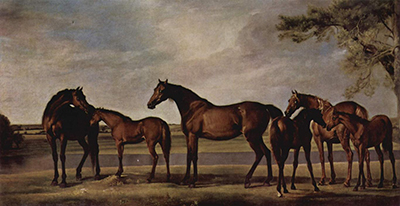Both inspired and fascinated by equine anatomy, the protective mares alongside their fouls in Mares and Foals are Anxious before a Looming Storm, which was created in 1965, are clearly the intended centre piece of George Stubbs's painting.
Renowned for his technique of painting the horses first and the background second, Stubbs's mixture of pale and murky hues in the sky only further enhance the bold magnanimity of the horses. Oils were George Stubbs's primary material of choice and when he would first begin his process of painting onto the canvas, he would utilise a liquid dilute paint when depicting the horses. Then, to further develop and layer colour and texture, he would subtly blend with the less superior background and the lighter tones from the clouds: this technique quite deliberately outlines the horses and accentuates their regal nature and magnanimity.
George Stubbs's took an autonomous approach to developing his artwork and despite gaining some insight and skill from a couple of his older friends, Richard Wright and William Caddick; in addition to some brief mentoring from the painter, Hamlet Winstanley, Stubbs possessed a natural and intuitive approach to painting that encapsulated the quintessence of 18th Century Romanticism. Typical of the Romanticist Era, it was conventional for emotions such as fear, uncertainty and anxiety to be captured and emphasised throughout paintings and literature: not only was Stubbs's knowledgeable about the physical form and structure of horses, but he was also attuned to the psychology and nature of them.
The rich tones in the sky clearly draws the onlooker of the painting to the emotion that is conveyed in the animals' eyes and reflects Stubbs's genuine curiosity about them. The chestnut brown of the horses bodies also creates a striking contrast to the backdrop, and the mare, which is central to the painting, has a dark shadow that leads the natural eye closer towards the real substance and feelings of this particular horse.
Although George Stubbs's work was not especially acclaimed in the public sphere until the 20th century, his ability to produce such an authentic representation of horses led him to possess a reputation for producing paintings with more accuracy than predecessors such as James Seymour and John Wooton.




